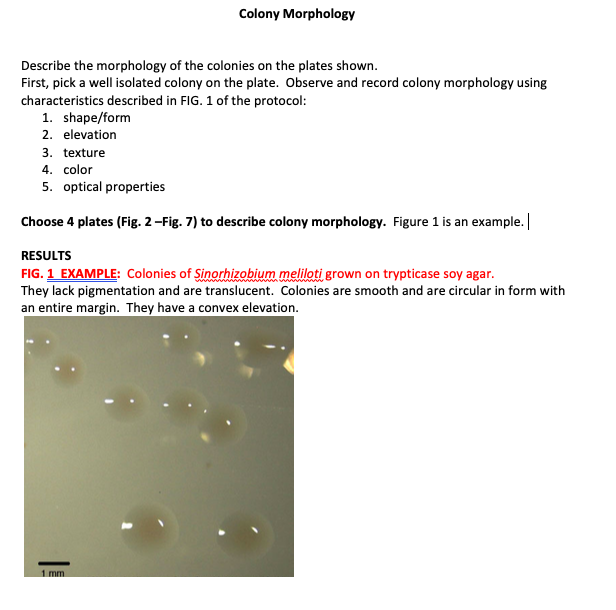The Texture of Serratia Marcescens Can Best Be Described as
The bacteria can produce prodigiosin a pigment color that ranges from lights pink to dark red. Marcescens cases in newborns was published in 1961 Urmenyi and Franklin 1961.

Solved 2 1 Colony Morphology Observations And Chegg Com
Gram stain for Serratia marcescens.

. Serratia marcescens a Gram-negative rod-shaped facultative anaerobe Fig. At room temperature it produces a red pigment. Marcescens IE has been infrequently described in the literature we believe that our cases are worth reporting to contribute to the present incidence and management of S.
The bacteria responsible has been identified as a pigmented Serratia marcescens strain. Marcescens is a gram-negative bacillus that occurs naturally in soil and water and produces a red pigment at room temperature. Serratia marcescens a motile gram negative bacillus which has been classified as a member of the family Enterobacteriaceae is widespread in the environment but it is a rare cause of human disease.
Serratia marcescens is a naturally occurring bacterium that can develop in a number of common places including. Accurate identification is important in defining outbreaks. The most common cause of this pink stuff is a red or pink pigmented bacteria known as Serratia marcescens.
Mixed growth of mucoid Lactose fermenting colonies and NLF colonies in MacConkey Agar Bacterial colonies are frequently shiny and smooth in appearance. Marcescens is circular and has a red to orange pigment due to the production of prodigiosin. Marcescens is a motile short rod-shaped Gram-negative facultative anaerobic bacterium that is classified as an opportunistic pathogen.
It is naturally occurring in soil and water. Serratia marcescens is short and rod shaped. Soil water sinks bathtubs and.
Serratia marcescens is a rare opportunistic bacterium that is categorized in the enterobateriaceae family commonly found in the environment. Pediatric outbreaks of marcescens have exhibited as bloodstream infection conjunctivitis eye infections pneumonia urinary tract. Serratia marcescens is commonly found in the environment particularly in consistently damp conditions where the bacteria grow rapidly.
Information on Causes Diagnosis Treatments. Serratia Marcescens is a human pathogen which means that it is known to cause disease in humans. Infective endocarditis serratia marcescens splenic infarcts renal infarcts intravenous drug use ivdu.
It is a facultative anaerobe meaning that it can grow in either the presence of oxygen aerobic or in. Marcescens displays relatively low virulence it causes nosocomial hospital acquired infections and outbreaks in severely immunocompromised or critically ill patients particularly. The incidence was 846 per 1000 liveborn infants.
It is associated with urinary and respiratory infections endocarditis osteomyelitis septicemia wound infections. Rod-shaped bacteria bacilliform bacteria or bacilli describe the typical shape of Serratia marcescens. Serratia marcescens has a history of causing infections in both children and adults.
Browse 300 serratia marcescens stock photos and images available or search for staphylococcus aureus or escherichia coli to find more great stock photos and pictures. Serratia marcescens is a species of bacteria that is known to be a highly opportunistic pathogen that is commonly involved in hospital acquired infections. A particular alteration in cooked and refrigerated pork meat is here described.
When grown on TSA for 48 hours at 37C then held at room temp for 24 hours S. Serratia marcescens is a type of bacteria. Other Serratia species are much less common.
In this paper we describe a new variant with prolific pigment prodigiosin. Jane Buckle PhD RN in Clinical Aromatherapy Third Edition 2015. A report from our own institution from 1989 described a prolonged outbreak with 222 cases of neonatal septicemia andor meningitis in the period between 1983 and 1988.
Serratia marcescens and Serratia liquefaciens are mainly cause of hospital-acquired infections. This bacterial pathogen has been isolated from several human clinical specimens and some non-human sources. Marcescens gram stain shows short pink-colored dots as seen below.
There have been many reports concerning the identification antibiotic susceptibility pathogenicity epidemiological investigations and typing of this organism. The color can identify the age of the bacterial colony which thrives in the soil. Serratia species that can be identified by the Vitek 2 GN card from bioMerieux are S.
While the most strains do not produce color some have a redpink color at temperatures below 986 F. Serratia marcescens is a gram-negative rod-shaped facultatively anaerobic bacterium that is extremely motile. The bacteria will grow in any moist location where phosphorous containing.
Gram stain S. Entomophila in addition to those listed. Other surface descriptions might be.
Some produce red pigment on MAC when grown at room temp. The Serratia species are occasionally recognized as a cause of hospital acquired infections such as urinary tract infections respiratory tract. The first description of lethal S.
In immunocompromised patients they can cause wound infections infections of the kidney and urinary tract respiratory tract infections and sepsis endocarditis meningitis and prosthetic infections. Serratia Marcescens Diagnosis Treatment. Colonial morphology for S.
Marcescens belongs to the family Enterobacteriaceae which is commonly found in water soil animals insects plants 1Although S. Slow lactose fermentor-at 24 hours will. Serratia bacteria are common inhabitants of our environment and can be found in many places including human and animal feces dust soil and in surface waters.
The GENIII Gram-Negative Aerobic Bacteria system from Biolog can also identify S. Dull opposite of glistening veined rough wrinkled or shriveled glistening. It can turn expressed breast milk and soiled diapers pink in color.
1 is ubiquitous in water soil and natural settingsIt is easily grown in the lab and may serve as an ideal model for adaptation studies because of the natural color variation of S. Serratia marcescens is a nosocomial opportunistic pathogen. Over the last 30 years Serratia marcescens has become an important cause of nosocomial infection.
Raised wet looking and appear tan in other cases.

Serratia Marcescens Clone F Characteristics A Scheme Of An Ideal F Download Scientific Diagram

Microbio Lab Flashcards Quizlet

Solved Colony Morphology Describe The Morphology Of The Chegg Com
Komentar
Posting Komentar